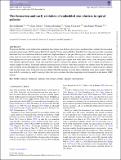Files in this item
The formation and early evolution of embedded star clusters in spiral galaxies
Item metadata
| dc.contributor.author | Rieder, Steven | |
| dc.contributor.author | Dobbs, Clare | |
| dc.contributor.author | Bending, Thomas | |
| dc.contributor.author | Liow, Kong You | |
| dc.contributor.author | Wurster, James | |
| dc.date.accessioned | 2021-12-23T14:30:04Z | |
| dc.date.available | 2021-12-23T14:30:04Z | |
| dc.date.issued | 2022-02-01 | |
| dc.identifier | 277040022 | |
| dc.identifier | ea7bee39-59e3-4737-846d-db5bdb336fa0 | |
| dc.identifier | 000780137000104 | |
| dc.identifier | 85126460745 | |
| dc.identifier.citation | Rieder , S , Dobbs , C , Bending , T , Liow , K Y & Wurster , J 2022 , ' The formation and early evolution of embedded star clusters in spiral galaxies ' , Monthly Notices of the Royal Astronomical Society , vol. 509 , no. 4 , stab3425 , pp. 6155-6168 . https://doi.org/10.1093/mnras/stab3425 | en |
| dc.identifier.issn | 0035-8711 | |
| dc.identifier.other | Jisc: 01b41267da41440390956a39f119e330 | |
| dc.identifier.other | ORCID: /0000-0003-0688-5332/work/105318648 | |
| dc.identifier.uri | https://hdl.handle.net/10023/24573 | |
| dc.description | The equipment was funded by BEIS capital funding via STFC capital grants ST/K000373/1 and ST/R002363/1 and STFC DiRAC Operations grant ST/K001014/1. DiRAC is part of the National E-Infrastructure. SR acknowledges funding from STFC Consolidated Grant ST/R000395/1. CLD acknowledges funding from the European Research Council for the Horizon 2020 ERC consolidator grant project ICYBOB, grant number 818940. | en |
| dc.description.abstract | We present Ekster, a new method for simulating star clusters from birth in a live galaxy simulation that combines the smoothed-particle hydrodynamics (SPH) method Phantom with the N-body method PeTar. With Ekster, it becomes possible to simulate individual stars in a simulation with only moderately high resolution for the gas, allowing us to study whole sections of a galaxy rather than be restricted to individual clouds. We use this method to simulate star and star cluster formation in spiral arms, investigating massive GMCs and spiral arm regions with lower mass clouds, from two galaxy models with different spiral potentials. After selecting these regions from pre-run galaxy simulations, we re-sample the particles to obtain a higher resolution. We then re-simulate these regions for 3 Myr to study where and how star clusters form. We analyse the early evolution of the embedded star clusters in these regions. We find that the massive GMC regions, which are more common with stronger spiral arms, form more massive clusters than the sections of spiral arms containing lower mass clouds. Clusters form both by accreting gas and by merging with other proto-clusters, the latter happening more frequently in the denser GMC regions. | |
| dc.format.extent | 14 | |
| dc.format.extent | 2381933 | |
| dc.language.iso | eng | |
| dc.relation.ispartof | Monthly Notices of the Royal Astronomical Society | en |
| dc.subject | Galaxies: star clusters: general | en |
| dc.subject | Galaxies: star formation | en |
| dc.subject | Methods: numerical | en |
| dc.subject | QB Astronomy | en |
| dc.subject | QC Physics | en |
| dc.subject | NDAS | en |
| dc.subject | MCC | en |
| dc.subject.lcc | QB | en |
| dc.subject.lcc | QC | en |
| dc.title | The formation and early evolution of embedded star clusters in spiral galaxies | en |
| dc.type | Journal article | en |
| dc.contributor.institution | University of St Andrews. School of Physics and Astronomy | en |
| dc.identifier.doi | https://doi.org/10.1093/mnras/stab3425 | |
| dc.description.status | Peer reviewed | en |
This item appears in the following Collection(s)
Items in the St Andrews Research Repository are protected by copyright, with all rights reserved, unless otherwise indicated.

